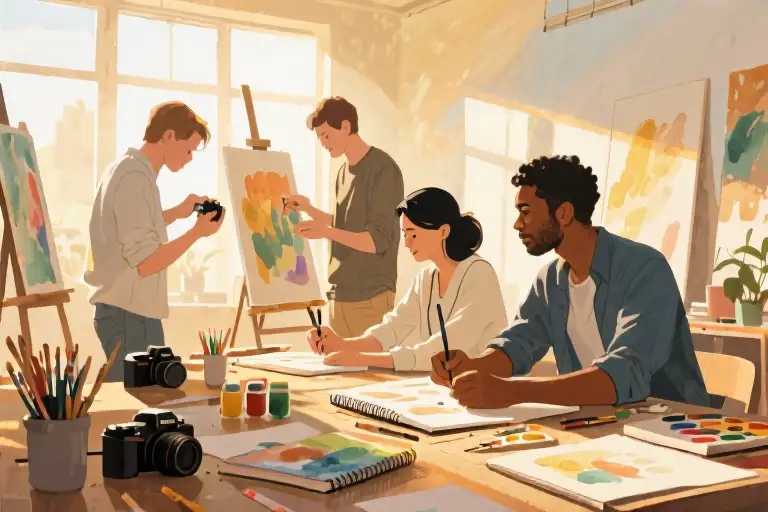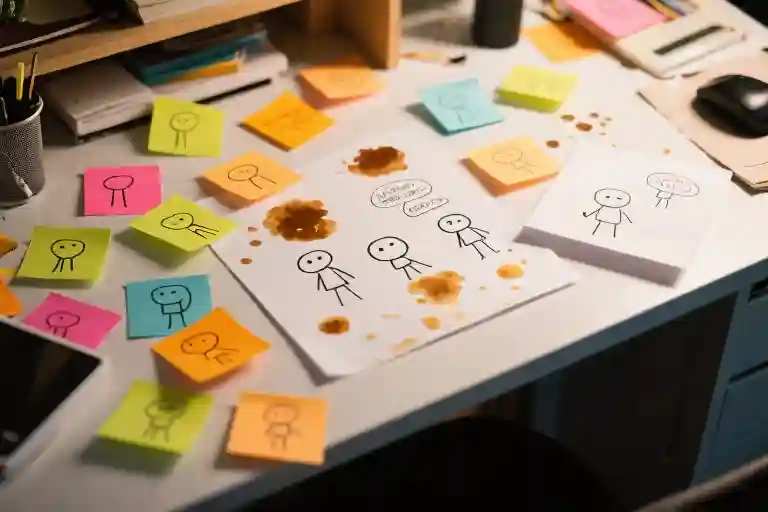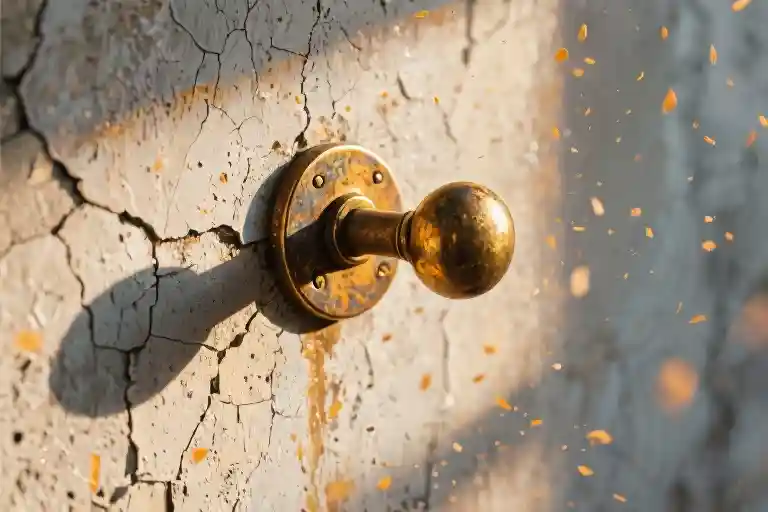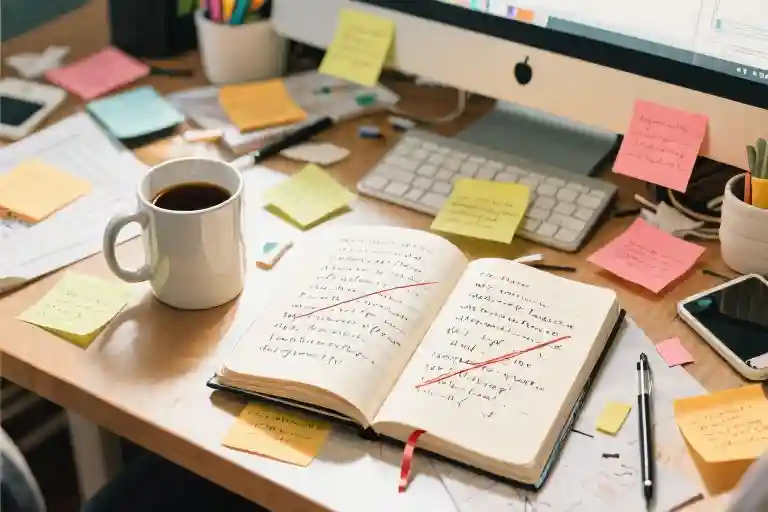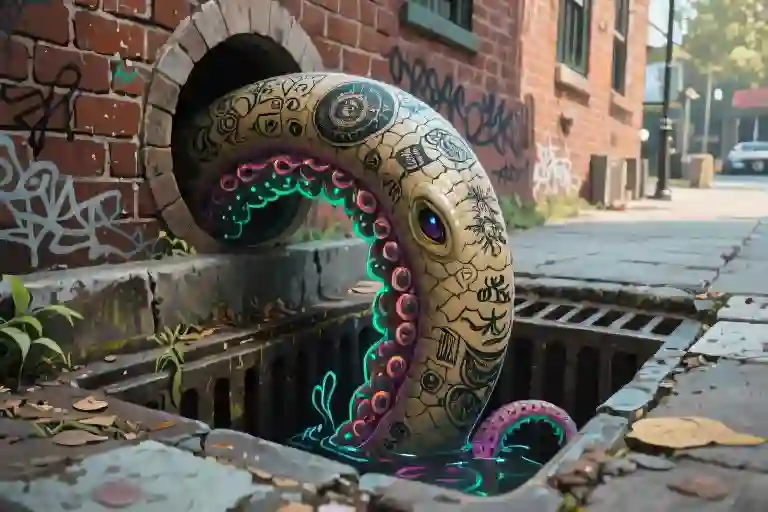There’s a peculiar emptiness that creeps in when I go too long without creating something. It starts as a faint whisper – a restlessness in my fingertips, a nagging sense that my thoughts aren’t quite landing where they should. Before long, it becomes a roaring silence, this unmet need to shape ideas into something tangible. Art isn’t just what I do; it’s how I breathe in this world.
Yet here’s the paradox every creator knows: the very thing that sustains us can sometimes feel like wading through quicksand. The projects that once sparked joy become routine. The blank page transforms from possibility to accusation. We find ourselves recycling the same techniques, the same themes, trapped in what psychologists call the ‘OK Plateau’ – that frustrating stage where we’re competent enough to continue, but no longer improving.
For years, I mistook this stagnation as failure. The nights staring at half-finished manuscripts, the abandoned sketchbooks, the camera gathering dust – I interpreted these as signs I wasn’t ‘cut out’ for creative work. Until I discovered something revolutionary: creative blocks aren’t roadblocks, they’re growth points in disguise. The friction we feel isn’t the death of inspiration, but the birth of our next artistic evolution.
What follows are five hard-won truths that transformed my creative practice. These aren’t theoretical concepts, but battle-tested strategies from the trenches of daily creation. They won’t promise instant genius (real art doesn’t work that way), but they will help you:
- Break free from creative ruts by learning how to ethically ‘steal’ like the masters
- Reignite your curiosity through deliberate cross-disciplinary exploration
- Develop an artist’s eye for the subtle details that elevate good work to greatness
- Build creative resilience for those inevitable days when inspiration plays hide-and-seek
- Expand your artistic vocabulary by engaging with perspectives outside your comfort zone
The creative life isn’t about constant fireworks. It’s about showing up – sometimes stumbling, sometimes soaring – but always moving forward. What makes an artist isn’t flawless execution, but the courage to keep translating the whispers of your soul into something the world can experience. Let’s begin.
Steal the Essence of Great Art (🎨)
We’ve all been there—staring at a blank page, cursor blinking mockingly, waiting for inspiration to strike like lightning. But here’s the truth professional artists rarely admit: originality often begins with thoughtful borrowing.
The Art of Creative Theft
Austin Kleon’s Steal Like an Artist revolutionized how we approach inspiration. His central premise? “All creative work builds on what came before.” This isn’t about plagiarism—it’s about recognizing genius in others’ work and adapting those sparks for your unique vision.
Consider how Shakespeare borrowed plots from historical chronicles, or how Picasso famously said, “Good artists copy, great artists steal.” The key difference lies in transformation versus duplication. When I first analyzed Margaret Atwood’s The Handmaid’s Tale, I didn’t copy her dystopian setting—I studied how she used sparse dialogue to build tension, then applied that technique to my own thriller manuscript.
Building Your Inspiration Archive
Start a Commonplace Book—a curated collection of creative fragments that move you. Mine includes:
- The haunting camera work in The Crown‘s “Aberfan” episode
- The rhythmic sentence structures in Ocean Vuong’s On Earth We’re Briefly Gorgeous
- The color symbolism in Studio Ghibli’s Spirited Away
Digital tools make this effortless:
- Notion (template link) for cross-referencing themes
- Evernote‘s web clipper to save striking advertisements
- A simple Notes app folder for sudden inspirations
“You are, in fact, a mashup of what you choose to let into your life.” — Austin Kleon
From Observation to Creation
Try this exercise with your next creative project:
- Identify 3 works you admire in your medium
- List their standout techniques (e.g., nonlinear timelines, chiaroscuro lighting)
- Combine elements from each into something distinctly yours
When I adapted this method for a recent short film, I blended:
- The lingering close-ups from Portrait of a Lady on Fire
- The natural lighting of Moonlight
- The sound design approach of A Quiet Place
The result? A festival-winning piece that bore my unmistakable signature while honoring my influences.
Remember: Artistic growth isn’t about reinventing the wheel—it’s about learning why the wheel works so well, then designing your own vehicle.
Pushing Creative Boundaries: How New Formats Spark Innovation
For years, I operated under the false assumption that creativity came with predetermined labels. As the sibling who ‘could write,’ I watched my brothers excel in painting and piano with quiet resignation, believing our talents were rigidly compartmentalized. This mental barrier began crumbling during a spontaneous high school improv performance – the moment I realized creative energy flows freely across artificial boundaries when we allow it.
Andy Warhol’s observation that “Everything has its beauty, but not everyone sees it” became my mantra as I started experimenting beyond my writing comfort zone. What began as tentative dabbling in watercolors revealed an unexpected truth: the narrative instincts I honed through fiction writing directly informed my visual compositions. Each brushstroke carried the same intentionality as a carefully chosen adjective, just channeled through a different medium.
The Cross-Pollination Effect
This creative cross-training yielded surprising benefits:
- Musical theater taught me rhythmic pacing that transformed my dialogue writing
- Photography refined my eye for revealing details that show rather than tell
- Abstract painting unlocked new metaphor-building techniques for poetry
Like a chef understanding how heat transforms ingredients differently in frying versus baking, exploring multiple creative formats reveals universal principles through varied applications. The musical Hamilton exemplifies this brilliantly – Lin-Manuel Miranda’s hip-hop storytelling techniques made historical narratives feel urgently contemporary because he refused to be constrained by traditional Broadway conventions.
Your Boundary-Breaking Challenge
This week, I invite you to conduct a simple but powerful experiment:
- Choose a core theme (e.g., loneliness, rebirth, injustice)
- Express it through your primary medium (write a poem, sketch, etc.)
- Reinterpret it through an unfamiliar format – If you’re a writer, try stop-motion animation using household items. Photographers might attempt haiku.
Document what shifts in your understanding of the theme when forced to communicate without your usual tools. Does sculpting a concept you normally write about reveal tactile dimensions you’d overlooked? Does converting a business presentation into a comic strip highlight unnecessary complexities?
Remember: You’re not abandoning your specialty, but enriching it. Just as traveling abroad deepens appreciation for home, creative boundary-pushing will bring fresh perspective to your primary craft. The goal isn’t mastery of new mediums (though you might discover hidden talents), but rather to stretch your creative thinking muscles in ways that inevitably strengthen your core practice.
“The artist is a receptacle for emotions that come from all over the place: from the sky, from the earth, from a scrap of paper, from a passing shape.” – Pablo Picasso
When we stop seeing ourselves as single-discipline creators and start embracing our role as multidisciplinary meaning-makers, we tap into a vast network of creative synapses waiting to be connected. Your next breakthrough might not come from another book about your craft, but from the way morning light filters through your shower curtain or the rhythm of a construction site outside your window.
Action Step: Keep a ‘cross-training journal’ this month noting:
- Unexpected connections between different creative acts
- How skills from one discipline solve problems in another
- Physical sensations (yes, really!) during creative flow states across mediums
Decoding the Intent Behind Details (🔎)
Great art lives in the details. Those subtle choices – a camera angle, a line delivery, a brushstroke – often carry more emotional weight than the grandest gestures. Learning to recognize and analyze these intentional details separates casual creators from true artists.
How Details Shape Emotional Impact
Take that breathtaking chase scene in Short Term 12. The handheld camera work creates visceral urgency as Brie Larson’s character runs through the streets. But notice how the cinematography shifts when she catches the boy – suddenly we get stable framing with shallow depth of field. That technical choice mirrors the emotional transition from chaos to connection. Director Destin Daniel Cretton could have shot the entire sequence with steady camerawork, but the intentional variation in technique amplifies the storytelling.
This principle applies across creative disciplines:
- Writing: The rhythm of sentence structures builds subconscious tension
- Painting: Directional brushstrokes guide the viewer’s eye movement
- Music: Strategic silence between notes creates anticipation
Case Study: Camera Angles as Emotional Language
Remember that CASA volunteer advertisement we discussed earlier? The genius lies in its perspective shifts. When showing the vulnerable child, the camera looks downward, making her appear small. But when focusing on her advocate, we get low-angle shots that convey strength without intimidation. This visual vocabulary communicates protection rather than dominance.
Such techniques aren’t accidental. Professional creatives make these decisions through:
- Storyboarding: Planning visual narratives frame-by-frame
- Shot Listing: Deliberately choosing camera positions
- Blocking: Choreographing movement within the frame
Practical Exercise: Developing Your Detail Radar
Try this three-step observational workout:
- Capture: This week, document three artistic details that emotionally resonate with you. These could be:
- A particularly moving scene from a film
- An arresting image in a photography exhibit
- A lyrical passage in a novel
- Analyze: For each example, ask:
- What specific element created the impact? (Lighting? Word choice? Composition?)
- How would the piece feel if this detail were changed?
- What might the creator have intended to communicate?
- Apply: Choose one technique to experiment with in your own work this month. For instance:
- If you admired a poet’s enjambment, try breaking your lines differently
- If a painting’s color palette moved you, explore analogous schemes
- If a song’s bridge transition surprised you, play with unexpected chord changes
“Structure creates meaning,” as Greta Gerwig observes. When we dissect how masters build their creations, we acquire tools for our own artistic toolbox. The details aren’t just decorations – they’re the hidden architecture of emotional truth.
Creative Challenge: Share one detail you’ve recently noticed in your favorite artwork and how it affected you. Tag #ArtisticDetails so we can learn from each other’s observations!
The Discipline of Creation: Building Habits for Inspiration Droughts
Every artist knows the paralyzing grip of a blank page. That moment when the cursor blinks mockingly, the paintbrush hovers uncertainly, or the camera lens captures nothing but static imagination. We’ve been sold the romantic myth that true art emerges only in lightning strikes of inspiration – but Matisse revealed the professional’s secret: “Don’t wait for inspiration. It comes while working.”
The 30-Day Experiment That Changed Everything
Three winters ago, I conducted a radical self-intervention. Despite having a bestselling novel deadline looming, I’d spent weeks rearranging my desk supplies instead of writing. So I made a pact: for 30 days, I’d create for at least 45 minutes daily – whether I felt “inspired” or not. The rules were simple:
- Micro-commitment: Just 5 minutes of actual work (often expanded organically)
- Permission for imperfection: Allowed to produce “terrible first drafts”
- Progress tracking: Color-coded calendar stickers for accountability
The results shocked me:
- Day 1-7: Forced paragraphs later deleted
- Day 8-14: Discovered unexpected subplot threads
- Day 15-21: Developed protagonist’s backstory through accidental doodles
- Day 22-30: Wrote the climactic chapter in one fluid overnight session
This wasn’t magic – it was the compound interest of creative habit. Neuroscientists confirm that regular creative practice physically restructures your brain’s default mode network, essentially building an “inspiration muscle.”
Your Anti-Procrastination Toolkit
1. The 5-Minute Trick
Set a timer for 300 seconds. Tell yourself you’ll stop afterward (you likely won’t). This bypasses the brain’s resistance to large commitments.
2. The Ugly First Draft Ritual
Designate a special notebook/Word doc titled “Allowed to Be Awful” where you:
- Write one intentionally bad sentence
- Sketch with your non-dominant hand
- Record 10 seconds of off-key humming
3. Environmental Triggers
Create sensory cues that signal “creation time”:
- A specific playlist (instrumental works best)
- Aromatic oils (research shows rosemary boosts creativity)
- Dedicated physical space (even just a corner with symbolic objects)
Download our printable Daily Micro-Creation Tracker with:
- Mood/energy level logging
- “Small win” celebration prompts
- Progressive difficulty scaling
When Resistance Feels Physical
On days when even 5 minutes seems impossible, try these physiological resets:
- Power posing: 2 minutes of “Wonder Woman” stance boosts confidence
- Bilateral stimulation: Alternate tapping knees to disrupt mental blocks
- Scribble therapy: Fast, chaotic mark-making to discharge tension
Remember: “Some days we make leaps and bounds, other times we crawl.” What matters isn’t today’s output quality, but maintaining the sacred rhythm of showing up. Your future self will thank you for every small act of courage against the blank page.
Action Prompt: Right now, set a phone reminder for tomorrow’s 5-minute creative session. Label it “Matisse’s Appointment.”
Expand Your Understanding of the World (🌎)
True creativity thrives when we step outside our cultural comfort zones. The most resonant art often emerges from the collision of diverse perspectives—think of Bong Joon-ho’s Parasite, which wove distinctly Korean class struggles into a universally gripping narrative. That film didn’t just entertain; it became a mirror reflecting shared human experiences through a culturally specific lens.
Why Cross-Cultural Creation Matters
- Fresh Perspective: When we engage with art from unfamiliar contexts, we discover new storytelling rhythms. A Japanese rakugo performance might inspire your dialogue pacing, while Nigerian Afrobeats could reshape your approach to narrative cadence.
- Emotional Universals: The Cinderella story exists in 500+ cultural variations. By studying how different traditions handle similar themes, we learn to craft work that transcends borders while honoring origins.
- Innovation Through Contrast: The tension between familiarity and novelty sparks breakthroughs. Lin-Manuel Miranda fused hip-hop with historical drama to create Hamilton—proof that daring combinations yield masterpieces.
Navigating the Respect vs. Appropriation Boundary
- The Golden Rule: Borrow aesthetics, not sacred cultural symbols. Research the difference between a Mexican alebrije (folk art anyone can appreciate) and a Native American war bonnet (reserved for tribal leaders).
- Credit Where Due: When Korean director Park Chan-wook cites Alfred Hitchcock as inspiration, he names him explicitly. Trace your creative lineage with equal transparency.
- Consult the Source: Before using elements from a culture not your own, seek input from its members. The Moana filmmakers formed an Oceanic Story Trust to avoid misrepresentation.
Your Cultural Expansion Toolkit
This Week’s Challenge:
- Film: Watch The Salesman (Iran) or Roma (Mexico)—notice how domestic spaces reveal societal structures.
- Music: Stream a traditional Maori haka alongside a Scottish battle chant. Compare their rhythmic storytelling.
- Local Immersion: Attend a cultural festival outside your community. Observe how rituals transform into art.
“The walls between art forms are made of tissue paper.” — Yo-Yo Ma
Remember: Expanding your worldview isn’t about collecting exotic references like souvenirs. It’s about letting diverse ways of seeing reshape your creative DNA. When we create from this enriched perspective, our art becomes a bridge—and bridges are what connect isolated islands into continents.
The Creative Journey Never Ends
Artistic creation isn’t a straight path—it’s more like a dance between crawling through valleys and soaring over peaks. Some days the words flow effortlessly, the brushstrokes feel guided by some unseen force, and the camera seems to frame perfect shots on its own. Other days? We stare at blank pages, wipe canvases clean repeatedly, and question every creative decision we’ve ever made. Both extremes are equally valid parts of the process.
The Rhythm of Creation
Henri Matisse once observed that “creativity takes courage”, but what he didn’t mention is how much patience it requires. That unfinished novel in your drawer, the half-painted canvas in your studio, the raw footage waiting to be edited—they’re not failures. They’re simply in the crawling phase of their creative lifecycle. The films that move us, the books that change our perspectives, the paintings that stop us mid-scroll—they all went through this same uneven rhythm.
What separates enduring art from abandoned projects isn’t innate talent, but the willingness to:
- Embrace the crawl when inspiration feels distant
- Recognize the leap when breakthroughs happen
- Persist through the uncomfortable middle ground between them
Your Turn to Create
Now that we’ve explored these five approaches—from strategic “artistic theft” to cross-disciplinary experimentation—I’d love to hear which resonated most with you. Did you:
- Start a Commonplace Book after reading about Austin Kleon’s method?
- Attempt that unfamiliar art form you’ve been curious about?
- Analyze three intentional details in your favorite film?
- Maintain a 30-day micro-creation streak despite busy schedules?
- Explore art from an unfamiliar culture this week?
Share your experiences with #CreativeCrawlLeap—whether it’s a triumph, a humorous failure, or an unexpected lesson. The creative community grows stronger when we exchange these stories.
Curated Resources for Continued Growth
For those seeking deeper dives into these concepts, here are personally vetted resources:
📚 Books to Steal From:
- Steal Like An Artist by Austin Kleon (affiliate link) – The foundational text on ethical artistic “theft”
- The Creative Habit by Twyla Tharp – Demystifies consistent creation
- Ways of Seeing by John Berger – Teaches observational artistry
🎬 Films to Study:
- Short Term 12 (2013) – Masterclass in emotional cinematography
- Parasite (2019) – Cross-cultural storytelling brilliance
- Everything Everywhere All At Once (2022) – Boundary-pushing genre fusion
🛠️ Practical Tools:
- Notion template for organizing creative influences (linked)
- 30-day micro-creation challenge calendar (free download)
- International art house cinema streaming guide
Remember what Picasso whispered to every artist: “Inspiration exists, but it has to find you working.” Keep showing up at the page, the canvas, the camera—not just when the muse sings, but especially when she’s silent. Your most important creation isn’t any single piece; it’s the resilient, curious, ever-evolving artist you’re becoming through the process itself.

